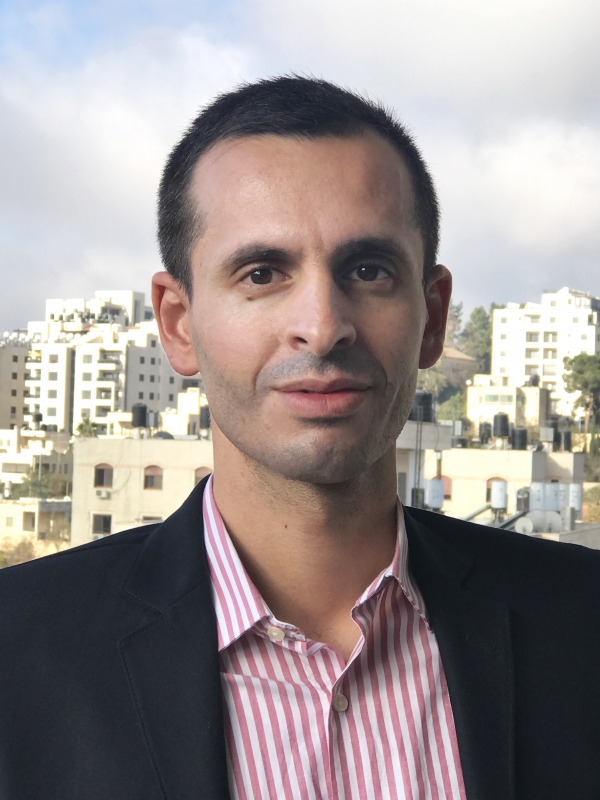City planning in the Palestinian-controlled areas has yielded poor results when it comes to unexpected challenges, including the recent outbreak of COVID-19, the novel coronavirus, says local expert Dr. Ahmad El-Atrash.
In this Guest Blog, Dr. Ahmad El-Atrash (pictured above) from the UN-Habitat office in Ramallah, reflects on the situation in Palestine.
Palestinian cities and communities are engulfed by multiple socio-economic, environmental, and geopolitical challenges. City planning in Palestine has been focused on the geopolitical conditions and on ways to increase the efficacy of the cities’ systems, including infrastructure, in light of the challenging operational environment, where Palestinians continue to have little to no control over borders and natural resources. Likewise, Palestinians have no control over historical and archaeological sites and natural landscape in occupied East Jerusalem and Area C of the West Bank. City planning in the Palestinian-controlled areas has yielded poor results when it comes to unexpected challenges, including the recent outbreak of COVID-19, the novel coronavirus.
Lockdown in Bethlehem
The way our cities – in particular, Bethlehem city and its environs at the time this piece was written – are facing this infectious disease has been a learn-by-doing process, par excellence. After the first cases of COVID-19 in Bethlehem, a state of emergency was declared, and gradually the Bethlehem area was placed under “home-quarantine” until further notice. Barricades have been erected, visitors and tourists barred, violators put into protective sequestration, schools and worship places closed, and street gatherings suspended. A de facto lockdown, so to speak, has been imposed that seems to be effective in curbing the outbreak of the virus.COVID-19 is a global public health crisis that all cities and countries are struggling to deal with, and it might be too early to draw the lessons learned from the response to it. One could start probing, however, the preparedness and contingency planning that our cities and communities are putting forward to fight any pandemic.
An epochal moment for city planners
Health is an underrated concept in Palestinian cities and communities when compared to adequate housing and transport, proper sanitation and waste management, and the provision of ample open green spaces for walking, cycling, and exercise. In addition, Palestinian cities and communities still have a long journey to make before they become drivers of measures that fight climate change.
This is an epochal moment for our city planners and policy makers to increasingly weigh in on how we understand and address the health consequences of our cities and communities. It is an opportunity to adopt a new health-centric approach to planning and development that could render our cities and communities more resilient.
How we face unprecedented public health crises needs to be coupled with the way we design and manage urbanization in Palestine, since more than 77 percent of Palestinians live in urban communities. Clearly, densification, for instance, has proven to be one of the main challenges in efforts to combat a COVID-19 outbreak. Rethinking density management is crucial for long-term survival in a pandemic world, recalling that this needs to be comprehended in the context of climate change and environmental sustainability. In case we choose to spread out our cities and communities rather than fostering intensification and densification, we need to consider implementing better urban-rural linkages, including efficient public transport. Part of this means revisiting the hierarchy of social services to ensure the decentralization of basic services.
Implementing this strategy in our cities and communities could be the way forward to rethink our built environment, especially water, sanitation, solid waste, and ICT systems that could reshape our cities, especially touristic ones. This outbreak could be the wake-up call to reinvigorate tourism and city planning in Palestine, recalling that modern cities and their infrastructural lines as we know them today were designed and built frequently in response to the spread of malaria and cholera in cities during the mid-nineteenth century.
COVID-19 is only a newcomer, joining a long list of infectious diseases that changed the way we think about our cities, such as the Spanish Flu of 1918, SARS Coronavirus of 2003, or the Ebola virus of 2014. While I hope that a treatment is found immediately to deal with COVID-19 in cities in the global north and south, I also hope that we show more and more discipline in our commitment towards fighting COVID-19. Ultimately, we must work together and leave a mark by enhancing a solid and resilient city-planning identity in Palestine that aims to realize inclusive, safe, resilient, and sustainable cities and communities. This is a global commitment for Palestine under the 2030 Agenda for Sustainable Development and the New Urban Agenda.
Ahmad El-Atrash is a Palestinian spatial planner and urban development specialist. He has extensive experience in working with think tanks, academic institutions, NGOs, and UN agencies on issues related to geopolitical and strategic planning, governance reform, resilience, and sustainable development within the Palestinian context. Ahmad holds a PhD in spatial planning from TU-Dortmund University in Germany. He can be reached at elatrash.ahmad@gmail.com.
This blog was first published in the April 2020 issue of the magzine This Week in Palestine, and is reproduced here with their kind permission and that of the author.
Other articles about Palestine on my website can be read here and here and here and here and here and here.

Schreibe einen Kommentar